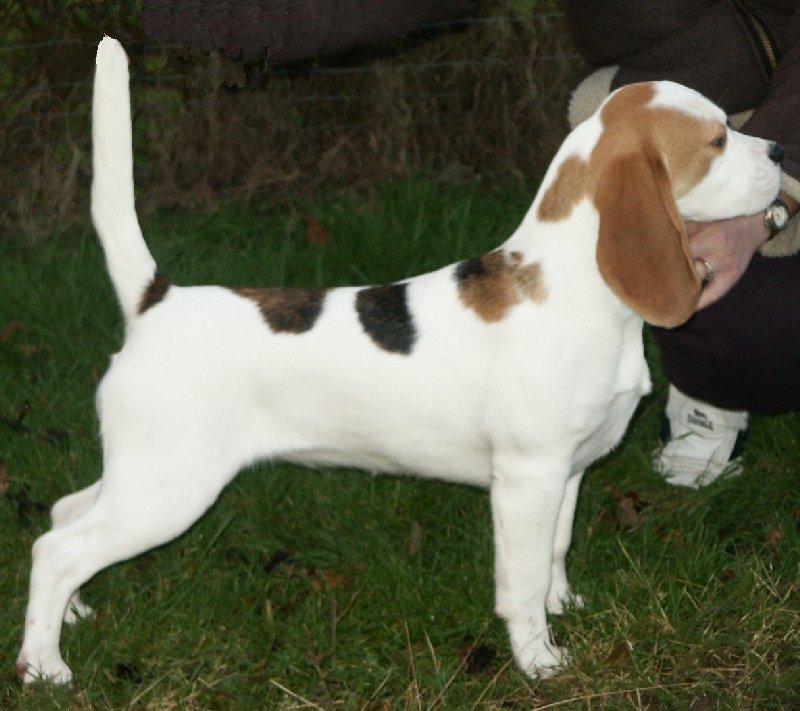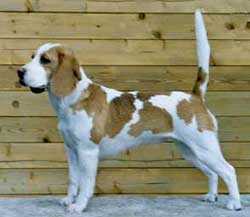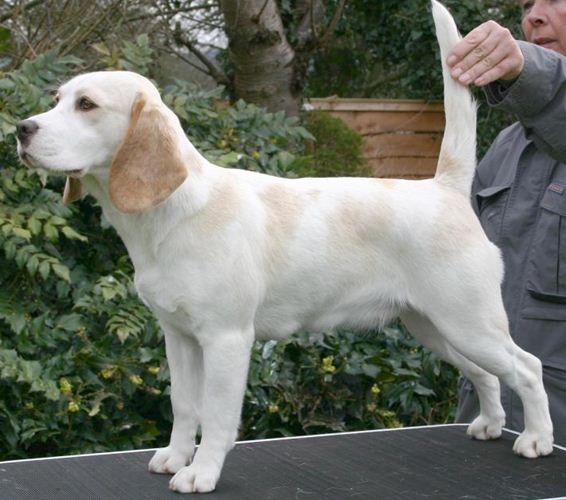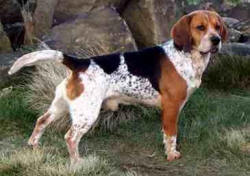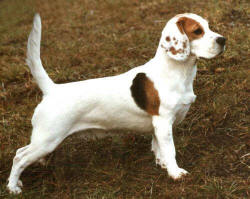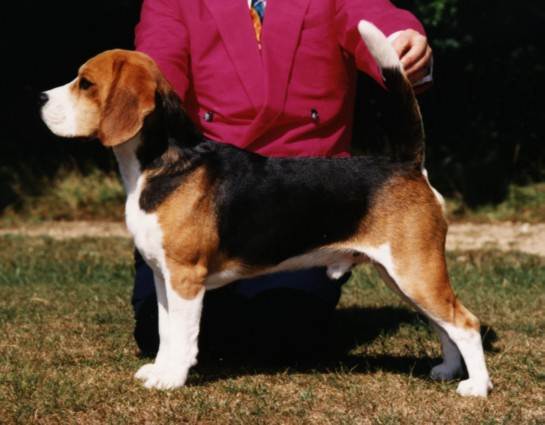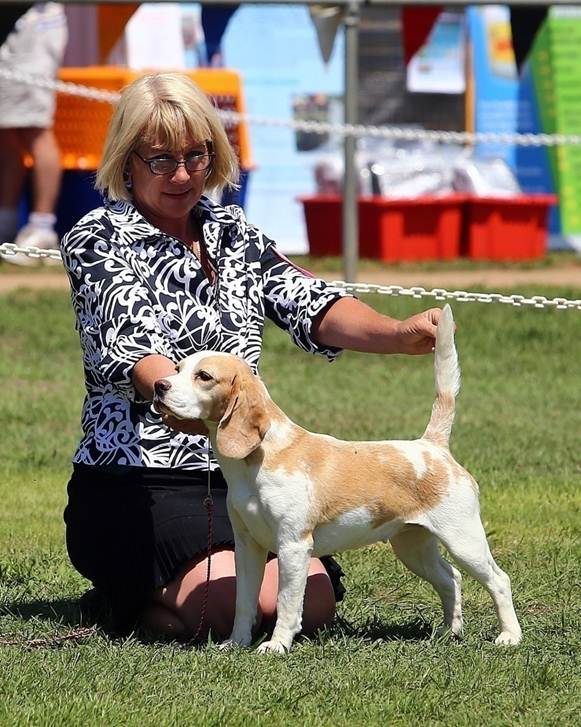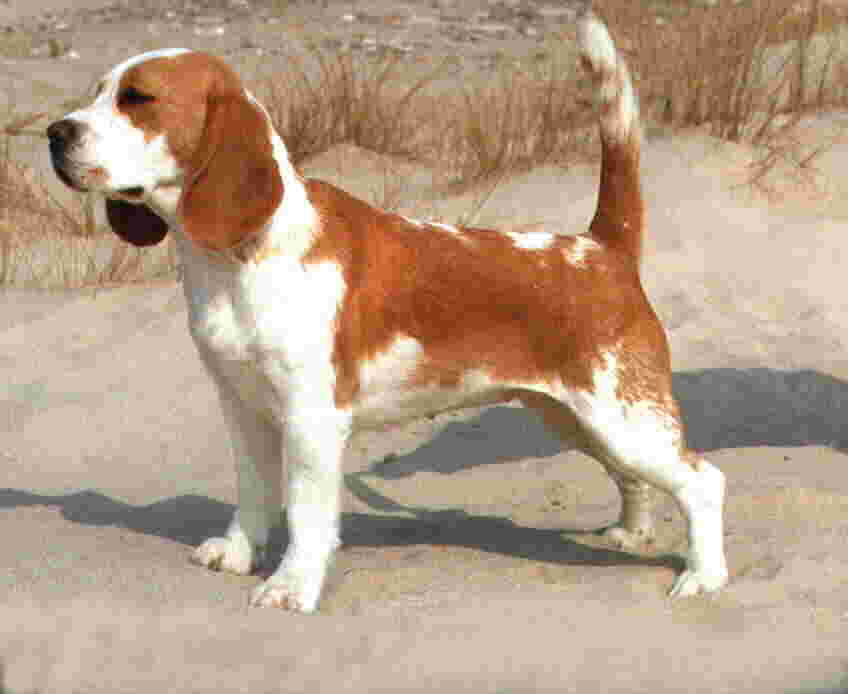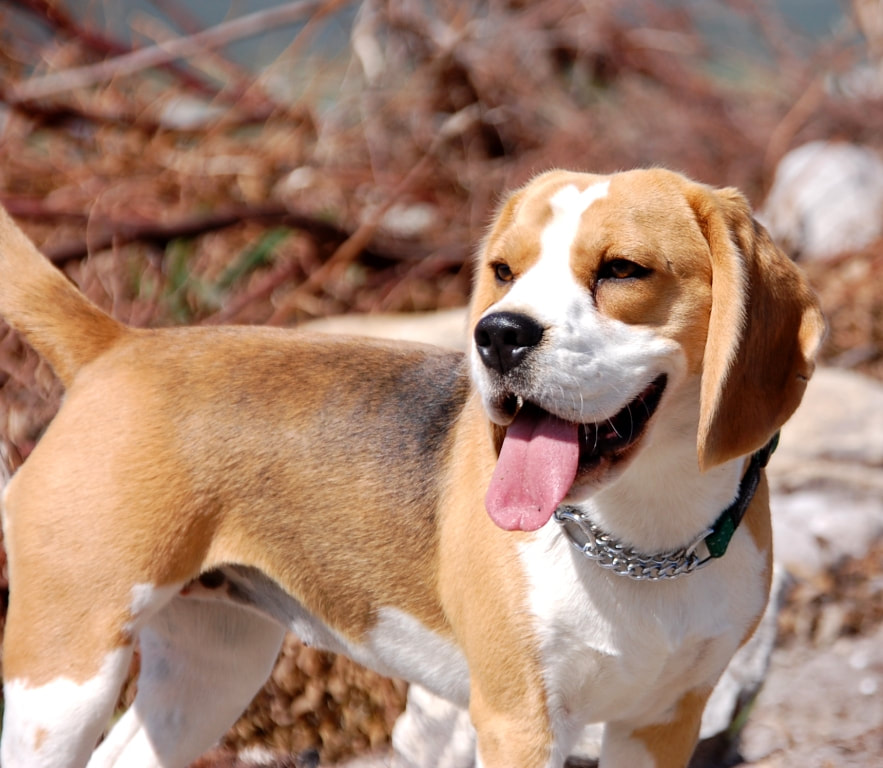|
In South Africa, the Beagle, and its breeding is regulated by the Kennel Union of South Africa (KUSA). KUSA is also the owner of the official breed standard, as displayed below.
Visit www.kusa.co.za for more. General Appearance. A sturdy, compactly built hound, conveying the impression of quality without coarseness. Characteristics. A merry hound whose essential function is to hunt, primarily hare, by following a scent. Bold, with great activity, stamina and determination. Alert, intelligent and of even temperament. Temperament. Amiable and alert, showing no aggression or timidity. Head and Skull. Fair length, powerful without being coarse, finer in the bitch, free from frown and wrinkle. Skull slightly domed, moderately wide with slight peak. Stop well defined and dividing length, between occiput and tip of nose, as equally as possible. Muzzle not snipey, lips reasonably well flewed. Nose broad, preferably black, but less pigmentation permissible in lighter coloured hounds. Nostrills wide. Eyes Dark brown or hazel, fairly large, not deep set or prominent, set well apart with mild, appealing expression. Ears. Long, with rounded tip, reaching nearly to end of nose when drawn out. Set on low, fine in texture and hanging gracefully close to cheeks. Mouth The jaws should be strong, with a perfect, regular and complete scissor bite, i.e. upper teeth closely overlapping lower teeth and set square to the jaws. Neck. Sufficiently long to enable hound to come down easily to scent, slightly arched and showing little dewlap. Forequarters. Shoulders well laid back, not loaded. Forelegs straight and upright well under the hound, good substance, and round in bone, not tapering off to feet. Pasterns short. Elbows firm, turning neither in nor out. Height to elbow about half height at withers. Body. Topline straight and level. Chest let down to below elbow. Ribs well sprung and extending well back. Short in the couplings but well balanced. Loins powerful and supple, without excessive tuck-up. Hindquarters. Muscular thighs. Stifles well bent. Hocks firm, well let down and parallel to each other. Feet. Tight and firm. Well knuckled up and strongly padded. Not hare-footed. Nails short. TAIL: Sturdy, moderately long. Set on high, carried gaily but not curled over back or inclined forward from root. Well covered with hair, especially on underside. Gait / Movement. Back level, firm with no indication of roll. Stride free, long-reaching in front and straight without high action; hindlegs showing drive. Should not move close behind nor paddle nor plait in front. COAT: Short, dense and weatherproof. Colour. Tricolour (black, tan and white); blue white and tan, badger pied; hare pied; lemon pied; lemon and white; red and white; tan and white; black and white; all white. With the exception of all white, all the above mentioned colours can be found as mottle. No other colours are permissible. Tip of stern white. Size. Desirable minimum height at withers: 33 cms (13 ins). Desirable maximum height at withers: 40 cms (16 ins). Faults. Any departure from the foregoing points should be considered a fault and the seriousness with which the fault should be regarded should be in exact proportion to its degree and its effect on the health and welfare of the dog and on the dog’s ability to perform its traditional work. Note. Male animals should have two apparently normal testicles fully descended into the scrotum. Only clinically and functionally healthy dogs with breed typical conformation should be used for breeding. |
Official Breed Colours
"Just as colour prejudice among humans causes problems throughout the world, the colour of Beagles has caused considerable controversy among their breeders, exhibtors and judges. Non specialist judges are frequently unaware of the wide variety of colours found among Beagles, so tend to prefer the traditional tricolour, whereas some specialist breeders and judges show a definte preference for a particular colour. While colour prejudice has not completely disappeared in the UK, it is much less than is found in some European countries, Australia, New Zealand, South Africa and the USA.
One of the causes of colour problems is the interpretation of the Breed Standard (UK) which states: "Any recognized hound colour other than liver. Tip of stern white". This means that no colour or combination of colours, is more correct than another and the distribution of colour or markings does not matter, providing the tip of stern is white. With one exception, no hound can have a wrong colour, that exception is liver which is considered objectionable because it is frequently accompanied by very light eyes, or even green eyes with pink rims. - ( Lilac & Chocolate are not recognized hound colours.)
Of the recognised hound colours the three basic ones are black, white and tan, each of which can vary in shade, even black & white! The total number of combinations these three colours can provide is 14 which can be divided into the following groups:-
Tricolours
Have solid patches of the three basic colours - because tricolours used to be and still are the most numerous they were frequently regarded as the traditional and only group. Tricolours with large patches of white are described as "flashily"or "brightly "marked; those with a large area of black are often referred to as "black blanketed" hounds. A typical description from a non specialist judge hedging his bets is "hound marked".
Two Colours
(not normally referred to as bi coloureds) They have become popular in the UK and frequently possess great quality. White is the basic colour accompanied by tan, which can vary from a pale lemon shade to rich chestnut. Those with a pale lemon colouring are "Lemon & Whites"; those having a darker shade of tan are "Tan & Whites". if the has a reddish or orange tinge, the hound is a "Red & White". Black & white is permissable is rarely found.
Single Colour
The only single colour permitted is white. This is rarely found but there have been several examples with small patches of very pale tan barely visible from a distance.
Pieds:
Pied hounds are those in which the three basic colours intermingle and do not occur in solid patches except white. Where the hairs of one colour predominate, the overall shade changes and gives rise to several types of pied hounds: "Lemon Pied"mainly lemon or cream hairs intermingling with black or white: "Hare Pied", more tan than black or white, giving a coat resembling that of a hair, and "Badger Pied"which contains a majority of black hairs. The pieds are found less frequently than the other colour combination groups.
Mottles
Similar to tri colours and the two coloured hounds but with small black and tan spots, known as flecks or mottles on the white parts. The names used to describe these are "Tri Colour Mottles", "Lemon Mottles", "Tan Mottles"and "Red Mottles".
Many years ago some hounds found in Wales and Southern Ireland had a definite bluish tinge to the black and were correctly called 'Blue ,Tan & White". Nowadays these are rare but some have been seen recently in Australia & the USA. These "Blue, Tan & Whites" can have blue flecks and are therefore called "Blue Mottles".
A lighter shade of blue, almost a slate grey has been seen on rare occasions but they are usually accompanied by light eyes. The blue/grey colour is not a true colour but a degenerate black which should not be regarded as a recognised hound colour.
It should be remembered that the colours of newly whelped puppies can change. For example the head, ears & shoulders of tri colour puppies are often black but gradually turn to tan during the next few weeks. Similarly shades of cream, brown or grey on the back usually disappear fairly soon and a covering of little white spots all over the black and tan usually disappears within 12 weeks, to the relief of novice breeders. Hounds not possessing a strong deep shade of black often loose it in old age and can appear almost white.
The size, symmetry or distribution of colour does not matter, with the exception of a white tip to the stern, but they can create optical illusions of which a judge should be aware. For example on the head, a wide white blaze down the middle of the forehead between the eyes makes the head look too broad, and an unbroken black blanket from head to stern can make the hound look too long. A white patch on the spine can give the impression of an uneven topline, and uneven tan & black markings down the legs, both front & rear, can give an impression of loose elbows, poor angulation and poor movement.
Beagles are found in a great variety of colours, virtually all of which are correct, and it is one of the factors which have made the breed so popular. Personal preference may be permitted in breeding & exhibiting, but never in judging. Without doubt, these colours must all be encouraged and no prejudice against one or another be allowed to develop. "
Source - David Webster, thebeagleclub.org, 1999
One of the causes of colour problems is the interpretation of the Breed Standard (UK) which states: "Any recognized hound colour other than liver. Tip of stern white". This means that no colour or combination of colours, is more correct than another and the distribution of colour or markings does not matter, providing the tip of stern is white. With one exception, no hound can have a wrong colour, that exception is liver which is considered objectionable because it is frequently accompanied by very light eyes, or even green eyes with pink rims. - ( Lilac & Chocolate are not recognized hound colours.)
Of the recognised hound colours the three basic ones are black, white and tan, each of which can vary in shade, even black & white! The total number of combinations these three colours can provide is 14 which can be divided into the following groups:-
Tricolours
Have solid patches of the three basic colours - because tricolours used to be and still are the most numerous they were frequently regarded as the traditional and only group. Tricolours with large patches of white are described as "flashily"or "brightly "marked; those with a large area of black are often referred to as "black blanketed" hounds. A typical description from a non specialist judge hedging his bets is "hound marked".
Two Colours
(not normally referred to as bi coloureds) They have become popular in the UK and frequently possess great quality. White is the basic colour accompanied by tan, which can vary from a pale lemon shade to rich chestnut. Those with a pale lemon colouring are "Lemon & Whites"; those having a darker shade of tan are "Tan & Whites". if the has a reddish or orange tinge, the hound is a "Red & White". Black & white is permissable is rarely found.
Single Colour
The only single colour permitted is white. This is rarely found but there have been several examples with small patches of very pale tan barely visible from a distance.
Pieds:
Pied hounds are those in which the three basic colours intermingle and do not occur in solid patches except white. Where the hairs of one colour predominate, the overall shade changes and gives rise to several types of pied hounds: "Lemon Pied"mainly lemon or cream hairs intermingling with black or white: "Hare Pied", more tan than black or white, giving a coat resembling that of a hair, and "Badger Pied"which contains a majority of black hairs. The pieds are found less frequently than the other colour combination groups.
Mottles
Similar to tri colours and the two coloured hounds but with small black and tan spots, known as flecks or mottles on the white parts. The names used to describe these are "Tri Colour Mottles", "Lemon Mottles", "Tan Mottles"and "Red Mottles".
Many years ago some hounds found in Wales and Southern Ireland had a definite bluish tinge to the black and were correctly called 'Blue ,Tan & White". Nowadays these are rare but some have been seen recently in Australia & the USA. These "Blue, Tan & Whites" can have blue flecks and are therefore called "Blue Mottles".
A lighter shade of blue, almost a slate grey has been seen on rare occasions but they are usually accompanied by light eyes. The blue/grey colour is not a true colour but a degenerate black which should not be regarded as a recognised hound colour.
It should be remembered that the colours of newly whelped puppies can change. For example the head, ears & shoulders of tri colour puppies are often black but gradually turn to tan during the next few weeks. Similarly shades of cream, brown or grey on the back usually disappear fairly soon and a covering of little white spots all over the black and tan usually disappears within 12 weeks, to the relief of novice breeders. Hounds not possessing a strong deep shade of black often loose it in old age and can appear almost white.
The size, symmetry or distribution of colour does not matter, with the exception of a white tip to the stern, but they can create optical illusions of which a judge should be aware. For example on the head, a wide white blaze down the middle of the forehead between the eyes makes the head look too broad, and an unbroken black blanket from head to stern can make the hound look too long. A white patch on the spine can give the impression of an uneven topline, and uneven tan & black markings down the legs, both front & rear, can give an impression of loose elbows, poor angulation and poor movement.
Beagles are found in a great variety of colours, virtually all of which are correct, and it is one of the factors which have made the breed so popular. Personal preference may be permitted in breeding & exhibiting, but never in judging. Without doubt, these colours must all be encouraged and no prejudice against one or another be allowed to develop. "
Source - David Webster, thebeagleclub.org, 1999
A question of nicety - Size in the Beagle
Non- specialist judges and people new to the breed frequently describe the ideal Beagle as being "Ä nice small Beagle "or a " A nice compact Beagle".
A few points are to be made here - all Beagles are nice - but small is not necessarily nice, nor for that matter is big nice. What is nice is balance. There is no mention of the Beagle being a square dog in the breed standard but balance is required. The Beagle breed height standard ranges from 13 inches to 16 inches. Therefore a balanced Beagle of 13 inches is just as nice as a balanced Beagle of 16 inches and vice versa. Having said that, a Beagle is not a toy, but a working dog and must be able to hunt over open and rough ground and ploughed fields. On average, newly ploughed furrows are around 10 to 12 inches deep, so a balanced beagle of 13 inches at the withers will have difficulty hunting over such ground.
What is meant by balance? In a perfectly balanced Beagle, the height from the ground to the top of the withers, will equal the length from between the shoulder blades to the base of the tail. Therefore a 16 inch Beagle will have a longer body than a 13 inch Beagle. Get out your tape measures and measure your Beagles, you will be surprised by what you find. Visually Beagles may appear to be longer or shorter than they are in reality due to coat colour, markings, saddles and blankets. Saddled and vertically marked Beagles will appear shorter than blanketed and horizontally marked Beagles. Due to principles of colour saturation, lighter coloured Beagles appear larger and longer than their darker coloured colleagues. The moral of the story is don't judge by eye alone but use a measuring device, be it a tape measure, stick or piece of string to determine the height and length of your Beagles.
The norm for length of coupling is generally four fingers wide, significantly shorter, the dog will have difficulty moving soundly. Too short coupling will affect both hind & front movement as the dog will not be able to achieve the desired reach and drive, often resulting in a piston engine action in front and wobbly hocks or bicycling behind. Too long, the dog may move soundly but will be too stretched out. Beagles are bred to hunt, a dog with unsound movement will not be able to work effectively for a sustained period and will break down, so, a dog that is slightly too long in body is preferable to a dog which is crippled or has unsound movement due to being too short coupled. also extra length is more acceptable in a bitch than it is in a dog. These are views shared by a number of hound specialist judges.
Balance is also required in the length of legs. In the forelegs, the length from the top of shoulder to elbow should be equal to length from elbow to ground. Hind legs which are too long in hocks may result in a topline rising over the hindquarters. Beagles with the correct balance between forelegs and hindlegs usually have the desired level topline.
The head is another area where balance is desired and where checks can easily be made by the novice, breeder and judge alike. Leathers, when pulled forward should reach almost to the tip of the nose. The length from the tip of the nose to the stop should equal the length from the stop to the occiput bone. The width between the ears should equal the measurement from occiput to stop.
Finally because Beagles tend to grow and mature in spurts one should never become hypercritical regarding size or balance until the dog has reached physical maturity at about 18months. Give a young dog the benefit of the doubt. Movement on the other hand, generally doesn't change, other than muscling up behind, an unsound mover at 6 months is usually a faulty mover as an adult, and movement often deteriorates as the dog matures and ages.
Judges should not show a preference for a specific size but select winners from the most balanced hounds that fall within the breed height standard of 13 to 16 inches.
Remember, when selecting for breeding and judging, there is no perfect dog, so the degree of the fault must be taken into account and consideration given as to whether it is structural or cosmetic; and in the case of breeding whether it is a common fault in the proposed sire and dam and most importantly in either of their lines.
Source - S de Villiers, In Full Cry No 2, 2013
A few points are to be made here - all Beagles are nice - but small is not necessarily nice, nor for that matter is big nice. What is nice is balance. There is no mention of the Beagle being a square dog in the breed standard but balance is required. The Beagle breed height standard ranges from 13 inches to 16 inches. Therefore a balanced Beagle of 13 inches is just as nice as a balanced Beagle of 16 inches and vice versa. Having said that, a Beagle is not a toy, but a working dog and must be able to hunt over open and rough ground and ploughed fields. On average, newly ploughed furrows are around 10 to 12 inches deep, so a balanced beagle of 13 inches at the withers will have difficulty hunting over such ground.
What is meant by balance? In a perfectly balanced Beagle, the height from the ground to the top of the withers, will equal the length from between the shoulder blades to the base of the tail. Therefore a 16 inch Beagle will have a longer body than a 13 inch Beagle. Get out your tape measures and measure your Beagles, you will be surprised by what you find. Visually Beagles may appear to be longer or shorter than they are in reality due to coat colour, markings, saddles and blankets. Saddled and vertically marked Beagles will appear shorter than blanketed and horizontally marked Beagles. Due to principles of colour saturation, lighter coloured Beagles appear larger and longer than their darker coloured colleagues. The moral of the story is don't judge by eye alone but use a measuring device, be it a tape measure, stick or piece of string to determine the height and length of your Beagles.
The norm for length of coupling is generally four fingers wide, significantly shorter, the dog will have difficulty moving soundly. Too short coupling will affect both hind & front movement as the dog will not be able to achieve the desired reach and drive, often resulting in a piston engine action in front and wobbly hocks or bicycling behind. Too long, the dog may move soundly but will be too stretched out. Beagles are bred to hunt, a dog with unsound movement will not be able to work effectively for a sustained period and will break down, so, a dog that is slightly too long in body is preferable to a dog which is crippled or has unsound movement due to being too short coupled. also extra length is more acceptable in a bitch than it is in a dog. These are views shared by a number of hound specialist judges.
Balance is also required in the length of legs. In the forelegs, the length from the top of shoulder to elbow should be equal to length from elbow to ground. Hind legs which are too long in hocks may result in a topline rising over the hindquarters. Beagles with the correct balance between forelegs and hindlegs usually have the desired level topline.
The head is another area where balance is desired and where checks can easily be made by the novice, breeder and judge alike. Leathers, when pulled forward should reach almost to the tip of the nose. The length from the tip of the nose to the stop should equal the length from the stop to the occiput bone. The width between the ears should equal the measurement from occiput to stop.
Finally because Beagles tend to grow and mature in spurts one should never become hypercritical regarding size or balance until the dog has reached physical maturity at about 18months. Give a young dog the benefit of the doubt. Movement on the other hand, generally doesn't change, other than muscling up behind, an unsound mover at 6 months is usually a faulty mover as an adult, and movement often deteriorates as the dog matures and ages.
Judges should not show a preference for a specific size but select winners from the most balanced hounds that fall within the breed height standard of 13 to 16 inches.
Remember, when selecting for breeding and judging, there is no perfect dog, so the degree of the fault must be taken into account and consideration given as to whether it is structural or cosmetic; and in the case of breeding whether it is a common fault in the proposed sire and dam and most importantly in either of their lines.
Source - S de Villiers, In Full Cry No 2, 2013
Copyright 2024
Site sponsored and managed by Shutter Paws Canine Photography
Site sponsored and managed by Shutter Paws Canine Photography

